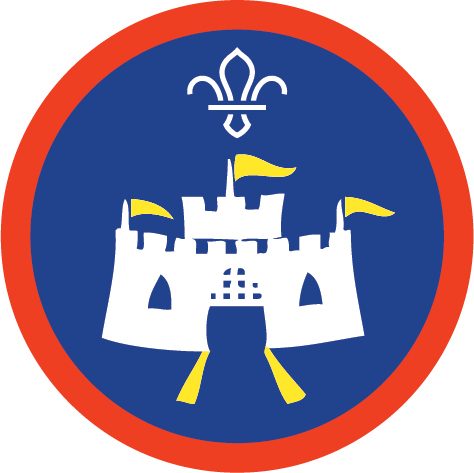
Incident hike
You’ll need
- Compass
- Paper maps
- Specific equipment for the games and activities
- Tokens to reward successful teams
Before you begin
- Use the safety checklist to help you plan and risk assess your activity. Additional help to carry out your risk assessment, including examples can be found here. Don’t forget to make sure all young people and adults involved in the activity know how to take part safely.
- Make sure you’ll have enough adult helpers. You may need some parents and carers to help if you’re short on helpers.
Planning your hike
- Plan a route around the local area with checkpoints. It's up to you how long the hike is and how frequent the checkpoints are.
- Make sure the checkpoints are positioned to allow the game or activity to be played without affecting access to the path.
- Plan activities at each checkpoint. We've included links to some games below.
- Make sure leaders are happy with the activities they're running and have all equipment ready before the hike begins.
- Make sure you have enough adults to run each checkpoint, as well as supervise the hike.
- Consider asking young leaders to help run the checkpoints.
- Decide on whether you are theming your hike. We've included a Pokémon themed example below.
- If you are providing reward tokens, make sure that there’s a scoring system in place that adults are informed of.
Activity Examples
You will need:
- Marshmallows
- Natural materials, such as dead wood and rocks
- Water
Give the team five minutes to make a mini-shelter for a marshmallow. When their time is up, place the marshmallow inside the shelter and pour water over it to see if the marshmallow stays dry.
You will need:
- First aid kit
- A way to hide the kit, such as a towel or coat over a tray
Lay out the contents of a first aid kit. Give the team 30 seconds to look at the items before hiding them. The team should try to name as many items as they can remember.
Check out this activity for more first aid ideas.
You will need:
- Scrap paper
- Measuring tape
Challenge the team to make a paper airplane that will fly across a distance of your choosing.
Ask the team to solve a riddle of your choosing. Here are a few examples:
Q: Take two apples from three apples and what do you have?
A: Two apples.
Q: What occurs once in a minute, twice in a moment, but never in an hour?
A: The letter M.
Q: I have cities but no house. I have mountains but no trees. I have water but no fish. What am I?
A: A map.
You will need:
- Hoops, sticks, chalk or similar to mark out a grid
- Cones or bean bags
Lay out a 3x3 three grid on the floor using the hoops, sticks or chalk.
Challenge the team to play giant noughts and crosses against the person running the checkpoint, with the team working in a relay for each move.
Check out this activity for more detailed instructions.
Challenge a member of the team to recite their Scout promise from memory.
Set the scene
- Everyone should split into small groups.
- Each group should receive a compass and a map showing the route, but don’t include the checkpoints. This is so each encounter will be a surprise.
- Make sure everyone is ready to walk. Have they got everything they need? Are they dressed appropriately for the weather and time of year?
- You might want to read everyone a story to set the scene for the theme of the incident hike.
Run the hike
- Each team should start the hike with a leader. They should have a map marked with the checkpoints, so they know when to anticipate the next activity.
- Consider staggering the start times, or starting the groups at different points along the route so that groups are less likely to bump into each other. Allow time for the checkpoint activities to be completed.
- Everyone should participate in the activities at the checkpoints.
- When everyone returns at the end of the hike, check everyone’s scores and see how all the teams have done.
Reflection
This activity was about being a team player and developing skills to try to beat the challenges at the checkpoints. In this activity you needed to work as a team. How did you work together during the hike? Did you walk at a pace that worked for everyone? How did you communicate? Did you enjoy working as a team during the challenges?
You also worked on your navigation skills to make sure you stuck to the right route. Did you find navigating challenging? Did you discover new routes or places that you hadn’t noticed before?
Safety
All activities must be safely managed. You must complete a thorough risk assessment and take appropriate steps to reduce risk. Use the safety checklist to help you plan and risk assess your activity. Always get approval for the activity, and have suitable supervision and an InTouch process.
- Road safety
Manage groups carefully when near or on roads. Consider adult supervision and additional equipment (such as lights and high visibility clothing) in your risk assessment.
- Dark
Provide some light, so the environment isn’t completely dark. Everyone must be able to see others and move around the area safely.
- Hiking and walking
Follow the guidance for activities in Terrain Zero, or the guidance for each the adventurous activity.
- Visits away from your meeting place
Complete a thorough risk assessment and include hazards, such as roads, woodland, plants, animals, and bodies of water (for example, rivers, ponds, lakes, and seas). You’ll probably need more adult helpers than usual. Your risk assessment should include how many adults you need. The young people to adult ratios are a minimum requirement. When you do your risk assessment, you might decide that you need more adults than the ratio specifies. Think about extra equipment that you may need to take with you, such as high visibility clothing, a first aid kit, water, and waterproofs. Throughout the activity, watch out for changes in the weather and do regular headcounts.
This activity can be led by you or someone else in Scouts
- Choose the activities and games that will be encountered along the way with your group’s ability in mind.
- Increase the challenge of following the route by running the hike in an area unfamiliar to everyone.
Make sure the routes and games you plan are accessible for everyone, for example by avoiding steps or including places to rest. If you’re likely to be outside when it’s dark, take a torch.
All Scout activities should be inclusive and accessible.
You can theme the hike however best suits your group. This also extends to the activities you choose, and can be designed to help achieve a wide range of badges.
Consider running this hike as part of a camp.


